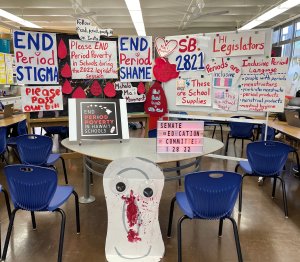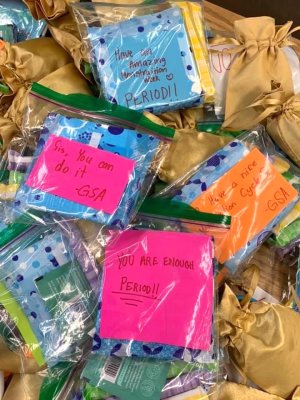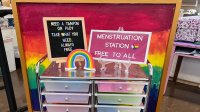How to Build a Menstruation Station at Your School
Nearly one in four students struggles to afford period supplies, which has a major impact on their ability to learn. Schools can help.
Your content has been saved!
Go to My Saved Content.There are 800 million people in the world menstruating at this very moment. Many menstruators, especially teenagers, struggle with period poverty, or the lack of access to period supplies and education. Nearly one in four students has struggled to access period supplies during the last school year, and nearly 80 percent either have missed class time themselves or know someone who has missed class time because of their lack of access to appropriate supplies. The data make it clear: Having access to clean and free period products helps menstruators stay in school and focus on learning.
Schools and teachers can play an important role in combating period poverty. If a student enters class without a pencil, I provide them with a pencil so they can engage in our learning activities. We can adopt the same attitude toward period products. Simply put: Period products are school supplies. So, how can we ensure that our school-aged menstruators can access products when they need them? Our solution was to build a classroom “menstruation station,” a place where all students who need them can access free period products.
Why You Should Build a Classroom Menstruation Station
I never meant to become the “period teacher.” But when a student was bullied for bleeding through her clothing (as happens in middle school), my students wanted to take action.
I channeled my students’ energy into period poverty research. As we explored the topic, I was not prepared for the stories my students shared. They admitted to using toilet paper, folder paper, socks, rags, and other items in place of clean period products. Recent local data found that some students even resort to using leaves when free period products aren’t available. Menstruators would tell me they liked the “thick pads” because you could “wring them out to keep using them.”

My students also felt that teachers believed they were using their period as an excuse for restroom breaks during class and that many teachers did not have compassion for their menstrual discomfort. When I share our menstrual equity work with teachers, I often notice that teachers are uncomfortable. I think that sometimes teachers feel regret that they didn’t realize how badly period poverty affects our students. However, teachers from across my school have been willing to openly display period products in their classrooms after learning about period poverty.
Once I learned that students were doing things that could be potentially bad for their current and future health, I couldn’t not act. For me, having a menstruation station in my classroom is social justice—or, more specifically, reproductive justice.
Collecting Supplies for Your Menstruation Station
It costs $5 to $7 per year per student to supply period products. Many schools or classrooms that have built menstruation stations have asked for funding from parent-teacher organizations (PTOs) to get started. However, as a veteran public school teacher who has only taught at underresourced schools, I have never worked on a campus that had a PTO in place. This year, we upgraded our physical station with the help of DonorsChoose, a crowdfunding platform for teachers.
We’ve supplied our station through a variety of means. My students elected to do a product drive to supply our station. PERIOD Movement offers an excellent resource on how to host a period product drive in your community. Doing one drive a year has kept our school of 700 students mostly stocked with products. We’ve received donations of period products from local groups as well. PERIOD will also ship supplies to your school if you request them.
Logistics of Menstrual Care Kits
Our cart has wheels so that it can be relocated to the main bathroom areas during lunch and recess. At other times, it sits by the front door to my classroom for easy access. I’ve also partnered with other teachers to store products in their classrooms so that students do not have to go far to get them.

As we are an island community, sustainability is always on our mind. We stock pads and tampons, with the hope of looking toward washable period pads and other more sustainable options in the future. Although some of my students are interested in menstrual cups, even the bravest students aren’t comfortable washing out a menstrual cup in front of their peers yet.
We sort our care kits with a variety of light, medium, and heavy products so that students can have supplies for their full cycle. We also include disposable wipes, and students add positive notes to encourage each other in the kits.
Two of the drawers in the station have products so that pouches can be refilled. I encourage students to come fill up their pouches on Fridays so that they have products during the weekend.
Ending Period Stigma
Getting supplies to students who need them and fighting menstrual stigma become a chicken-or-egg situation. The stigma is there because we don’t talk about it, but getting products out publicly does make the conversation easier. It’s been a process.
The stigma may be changing on a national level. This year alone, 37 states are deliberating legislation on period poverty, and five states require period products to be provided for free in public schools. Since 2019, my students have been championing bills to provide free period products in Hawaii public schools in the hopes of becoming the sixth state.
We’ve also seen local results. A few of my students have decided that good boyfriends carry a period pack for their girlfriends in their backpacks. It’s such a little thing, but I have to believe those small acts get us closer to ending period shame and stigma for all students.
